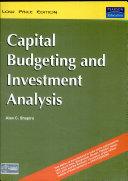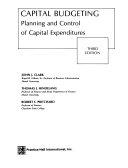
Capital Budgeting And Investment Analysis
Capital Budgeting and Investment Analysis marries theory with practice by providing numerous illustrations of real-world applications. It includes a discussion of capital budgeting's link to the corporation's strategy for creating value as well as addressing the international aspects of capital budgeting. The basic philosophy of this book is to help students develop their critical thinking skills required to assess potential investments. Topics covered include the basics of capital budgeting, the estimation of project cash flows and the project cost of capital, risk analysis in capital budgeting, and corporate strategy and its relationship to the capital-budgeting decision.
- ISBN 13 : 9788131719893
- ISBN 10 : 8131719898
- Judul : Capital Budgeting And Investment Analysis
- Pengarang : Shapiro,
- Penerbit : Pearson Education India
- Bahasa : en
- Tahun : 2008
- Halaman : 264
- Halaman : 264
- Google Book : http://books.google.com/books?id=SaJrHn_H8jAC&dq=intitle:Capital+budgeting&hl=&source=gbs_api
-
Ketersediaan :
The basic philosophy of this book is to help students develop their critical thinking skills required to assess potential investments.









